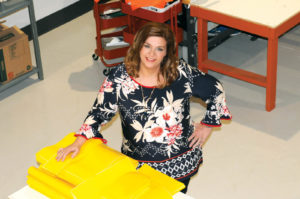 Cold calls are a thing of the past,” says Brenda Hagerty, co-owner and president of Porcupine Canvas Manufacturing Ltd. in Boucherville, Quebec, Canada. “Calling someone out of the blue to try to sell them something just doesn’t work in today’s industry. What clients want are our feet on the ground.”
Cold calls are a thing of the past,” says Brenda Hagerty, co-owner and president of Porcupine Canvas Manufacturing Ltd. in Boucherville, Quebec, Canada. “Calling someone out of the blue to try to sell them something just doesn’t work in today’s industry. What clients want are our feet on the ground.”
Hagerty’s history with Porcupine Canvas began in 2010 when she was hired for an inside sales position. Before that, she’d spent 25 years selling for a hydraulics company. “I’ve always loved sales, and I’ve always loved to sew,” she says. “Working at Porcupine combined my professional passion for sales with my personal passion for sewing—working in a sales position at a textile manufacturing company was my dream job.”
Timmins, Ontario, where Porcupine Canvas was located at the time, is home to several gold, zinc, copper, nickel and silver mines—and when Hagerty came on board, the majority of the company’s sales was to the mining industry. Porcupine sold mining equipment, including bags, vests, safety equipment, exploration supplies, tipis and mining tents.
Although it held a significant market share of the mining equipment industry, the company had never before hired a trained sales person—and the number of orders Hagerty landed caught the owner’s notice. He asked her to go out on the road. “So once a week, I’d visit the mines,” she says. “When you’re in the mines, that’s when you learn what the customer wants—not what you want to sell them, but what they need to make their lives easier. That’s when our sales started to grow exponentially.”
The majority of the company’s sales were in the Timmins area, and the sales outside the area were usually the result of miners who had previously worked in Timmins and were familiar with the quality and range of Porcupine’s products. “I started thinking: If miners in the Northwest Territories are ordering from us because there’s nobody closer to them supplying the kind of quality products we’re making—we should think about setting up distributorships,” Hagerty says.
She contacted Dan Villgren at Sudbury, Ontario-based Sling-Choker—a wire rope fabrication and industrial supply
company with 13 locations across Canada. “They were a good fit because they have inside sales people and outside sales people that make sales calls regularly to mines in those locations,” she says. “So we started distributing through them, and the sales growth was huge.”
From sales to the head office
Porcupine now has distributors in the U.S. and across Canada in addition to Sling-Choker. Near the beginning of 2012, Hagerty was promoted to assistant manager; by the end of that year she became general manager—and in 2015 she partnered with Villgren and purchased Porcupine. “The owner was getting ready for retirement, and although he was supportive of me selling more products, he was hesitant to invest the money needed for expansion and equipment,” Hagerty says. “When he initially approached me with the idea that I buy the business, he wanted me to partner with him and take over the company in five years, but I thought it would be better if I found a way to buy him out completely.”
When Hagerty reached out to Villgren to see if he would partner with her, his answer was an immediate yes. An expert in the mining industry, he operates mostly behind the scenes. “He’s the best business partner you could ever have,” she says. “When we first went into partnership he told me: ‘You just go with your ideas. If you try something and if it works, it works. If it doesn’t, we’ll try something else.’”
And when the time came to negotiate the terms of the sale, Villgren suggested that Hagerty’s life partner Bill Kowal take on the role. “Bill was used to negotiating huge contracts for corporations, so he was able to negotiate the price down,” Hagerty says. “And it kept me from having to negotiate with someone who at the time was still my boss.”
Yes to glamping tents
The company was strong and mining sales were still growing for Porcupine when an unexpected new market share practically landed in Hagerty’s lap. In January 2016, while at a mining trade show in Vancouver, it became clear to Hagerty and Villgren that glamping tents were in demand. “The CEOs of companies were stopping by our booth asking if we sold tents they could use for ‘bunkies’ at their cottages,” Hagerty says. “We sold more tents at that show than mining products, so we thought: ‘Maybe it’s time to give glamping tents its own website.’”
Porcupine launched Tenting in Luxury, a division of Porcupine Canvas, dedicated exclusively to luxury tents. Along with the glamping market came international growth. “We started dealing more with the U.S. and Mexico, and my strength is not international—my strength is Canada,” Hagerty says. “We decided we needed to hire somebody to help with all this international growth, and the name that kept popping into both Dan’s and my heads was Bill—he has contacts all over the world. So he came on board as director of sales and operations, and marketing.”
By Sigrid Tornquist, InTents editor and regular contributor to Specialty Fabrics Review.
 TEXTILES.ORG
TEXTILES.ORG


